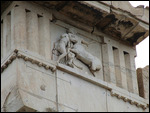Classical Athens (before 355 BC) was the cradle of Western civilization, where democracy was first adopted. It became a secondary center of Greek Orthodox Christianity during the long Byzantine rule when Constantinople was the seat of the emperors and the Church. Athens continued to be secondary to Constantinople under Ottoman Turkish rule, until becoming the capital of independent Greece.
before 355 BC - capital of the leading Greek city state. 431 BC - Parthenon temple completed.
to 146 BC - Greek rule from Macedonia (near Thessalonika, Greece).
to 395 AD - Roman rule from Rome, Italy.
to 1204 - Christian Byzantine/Greek rule from Constantinople (Istanbul, Turkey).
to 1458 - ruled by various Christian Crusader princes.
to 1833 - Muslim Turkish rule from Istanbul.
1833 - became capital of independent Greece.
This was my first time in Athens. We took a guided tour of the Acropolis offered by the cruise. Although it's not difficult to take public transportation, our stopover in Athens is shorter than a full day so taking a guided tour can save time. I have known of Athens and the Acropolis from textbooks and documentary films since childhood, where the Parthenon temple had been rated as the finest ever classical building with the perfect ("golden") proportions.
The weather didn't cooperate, it was drizzling outside. We took the tour bus from the port at Piraeus, passed by several Olympic stadiums built for the 2004 Athens Olympics, then drove into downtown. Our tour guide introduced us to the notable landmarks in downtown Athens, mostly built in the 19th and 20th centuries after Greece became independent from Ottoman Turkey. By and large the city was chaotic, full of 6-story contemporary buildings that didn't resonate with the image of the city as the cradle of classical (Western) civilization. Unlike Barcelona which is also mostly built in the 19th century it seems Athens had been totally cut off from its heritage. Housing almost half of all Greeks, it is no wonder modern urbanization has overrun any charm left from the ancient times.
Our first stop was the Panathinaikos statium, built entirely of pentelic marble in Roman times but refurbished for the first modern Olympic Games in 1896. It is an elegant structure with a simple design. Next our bus passed by a Roman-era temple ruin with only 7 massive columns standing, and one fallen on the ground due to an earthquake in modern times. Finally we arrived at the foot of the Acropolis, supposedly only 75 steps to climb it but in fact much higher. Most of the paths on the hill are sloping ramps paved by marble, making it very very slick in rainy weather. The foot of the Acropolis was surrounded by olive groves, among which is a Roman-era amphitheatre, still almost completely intact. Looking up one gazes on the venerable Parthenon temple at the top of the hill city, or Acropolis.
Climbing up the steps we passed by the gates of the Acropolis, paved by steep rocky steps and flanked by huge marble walls and columns. It was raining harder and us younger folks tried to make sure the elderly folks don't slip and fall on the very rough and rocky terrain on top of the hill. Most of the hill top is empty except for the twin temples: Parthenon on the right and the Erechtheion on the left, both of which were built in the 6th century BC during the peak of the Athenian city-state. Most of the massive columns of the Parthenon are intact but almost all of the friezes had been taken to the British Museum in the 19th century, making it an empty shell. The Erechtheion is famous for having the six front columns sculpted as female figures. Although only this much is left, it still evokes the elegant and brilliant civilization of the ancient Greeks, the birthplace of democracy, a unique form of government that didn't have many parallels in world history.
Looking out from the high point of the Acropolis one sees the entire Attiki plain surrounded by a ring of massive hills. The whole plain is covered to the rim by uniform contemporary 6-10 story flats without high rises, a rather depressing sight. Only one corner of the city next to the north side of the Acropolis (the Plaka neighborhood) has some red tile roofs and older houses been preserved. However, the dramatic dark rain clouds made it a beautiful view over the brooding, ancient ruins.
We returned to Piraeus by tour bus, then I went on a hunt for internet cafes. Walking around most of Piraeus' downtown I didn't find it, but I found it in the port building. There are some pretty Greek orthodox churches in town, some in the byzantine style, whose columns were draped by Easter's purple color.

